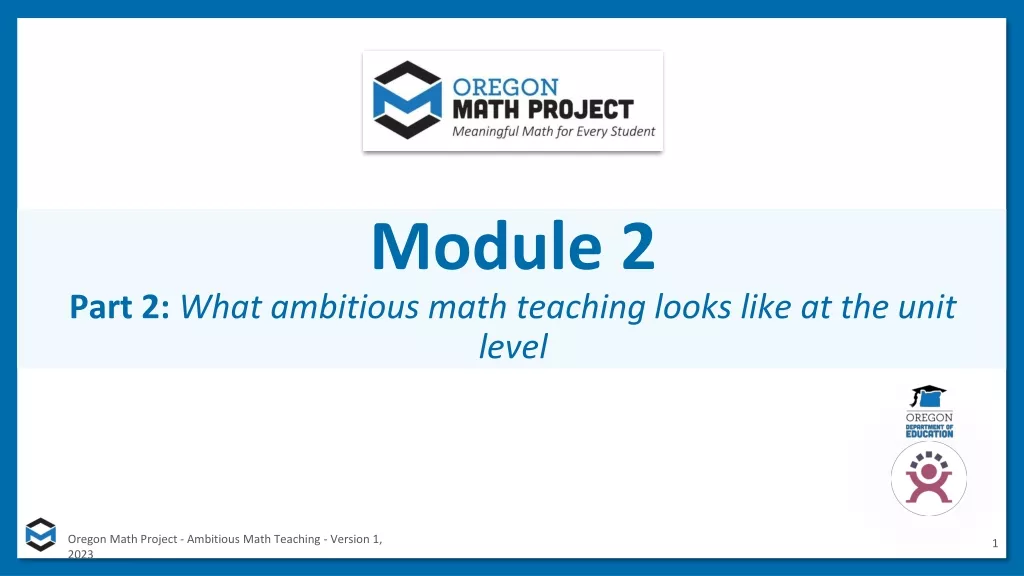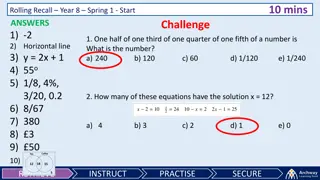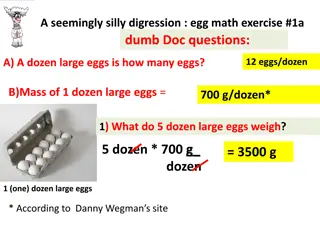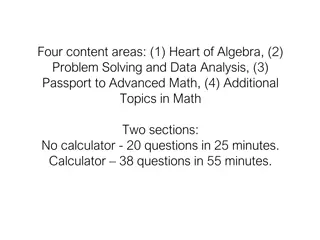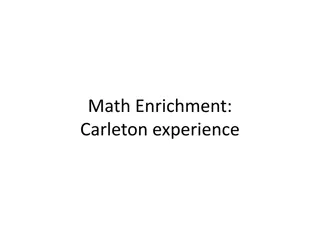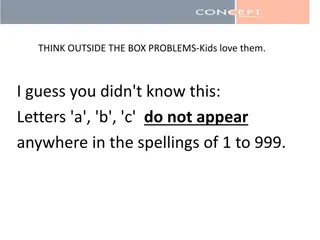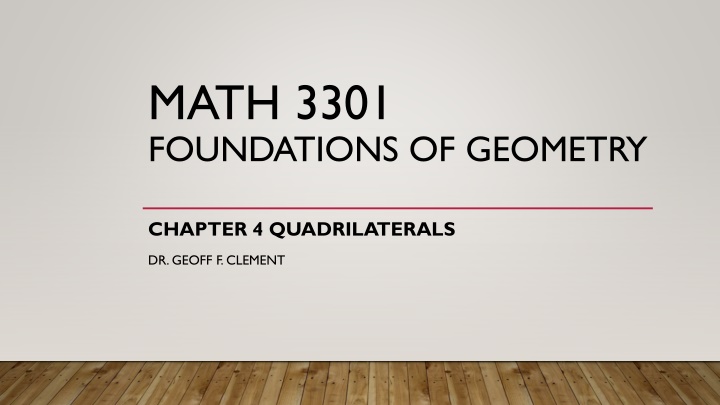
Geometry Basics: Understand Parallelograms and Their Properties
Dive into the world of parallelograms in geometry with this comprehensive chapter discussing definitions, theorems, and properties. Learn about parallel sides, congruent angles, diagonal properties, and methods to prove a quadrilateral is a parallelogram. Explore the intricacies of shapes with this exploration into quadrilaterals.
Download Presentation

Please find below an Image/Link to download the presentation.
The content on the website is provided AS IS for your information and personal use only. It may not be sold, licensed, or shared on other websites without obtaining consent from the author. If you encounter any issues during the download, it is possible that the publisher has removed the file from their server.
You are allowed to download the files provided on this website for personal or commercial use, subject to the condition that they are used lawfully. All files are the property of their respective owners.
The content on the website is provided AS IS for your information and personal use only. It may not be sold, licensed, or shared on other websites without obtaining consent from the author.
E N D
Presentation Transcript
MATH 3301 FOUNDATIONS OF GEOMETRY CHAPTER 4 QUADRILATERALS DR. GEOFF F. CLEMENT
4.1 PARALLELOGRAMS Definition: A parallelogram is a quadrilateral whose opposite sides are parallel.
4.1 PARALLELOGRAMS Theorem 4.1: Each diagonal divides a parallelogram into two congruent triangles.
4.1 PARALLELOGRAMS Corollary 4.2: The opposite sides and the opposite angles of a parallelogram are congruent.
4.1 PARALLELOGRAMS Theorem 4.3: Consecutive angles of a parallelogram are supplementary. Find x, y, and z.
4.1 PARALLELOGRAMS Theorem 4.4: The diagonals of a parallelogram bisect each other.
4.1 PARALLELOGRAMS Summary: Properties of a Parallelogram 1. Opposite sides are parallel. 2. Each diagonal divides it into two congruent triangles. 3. Opposite sides are congruent. 4. Opposite angles are congruent. 5. Consecutive angles are supplementary. 6. Diagonals bisect each other.
4.1 PARALLELOGRAMS Theorem 4.5: If both pairs of opposite sides of a quadrilateral are congruent, then the quadrilateral is a parallelogram. Theorem 4.6: If both pairs of opposite angles of a quadrilateral are congruent, then the quadrilateral is a parallelogram. Theorem 4.7: If two opposite sides of a quadrilateral are congruent and parallel, then the quadrilateral is a parallelogram.
4.1 PARALLELOGRAMS Theorem 4.8: If the diagonals of a quadrilateral bisect each other, then the quadrilateral is a parallelogram.
4.1 PARALLELOGRAMS Summary: Methods to Prove a Quadrilateral is a Parallelogram 1. Show that both pairs of opposite sides are parallel. 2. Show that both pairs of opposite sides are congruent. 3. Show that both pairs of opposite angles are congruent. 4. Show that one pair of opposite sides are congruent and parallel. 5. Show that diagonals bisect each other.
4.2 RHOMBUSES AND KITES Definition: A rhombus is a parallelogram that has two congruent adjacent sides. Theorem 4.9: All four sides of a rhombus are congruent.
4.2 RHOMBUSES AND KITES Theorem 4.10: The diagonals of a rhombus are perpendicular.
4.2 RHOMBUSES AND KITES Theorem 4.11: If the diagonals of a parallelogram are perpendicular, then the parallelogram is a rhombus.
4.2 RHOMBUSES AND KITES Theorem 4.12: The diagonals of a rhombus bisect the angles of the rhombus.
4.2 RHOMBUSES AND KITES Summary: Properties of a Rhombus 1. Opposite sides are parallel. 2. Diagonals divide it into two congruent triangles. 3. Opposite sides are congruent. 4. Opposite angles are congruent. 5. Consecutive angles are supplementary. 6. Diagonals bisect each other.
4.2 RHOMBUSES AND KITES Summary: Properties of a Rhombus 7. All sides are congruent. 8. Diagonals are perpendicular. 9. Diagonals bisect angles.
4.2 RHOMBUSES AND KITES Definition: A kite is a quadrilateral with exactly two distinct pairs of congruent consecutive sides.
4.2 RHOMBUSES AND KITES Theorem 4.13: If a quadrilateral is a kite, one pair of opposite angles is congruent.
4.2 RHOMBUSES AND KITES Theorem 4.14: If a quadrilateral is a kite, one diagonal is the perpendicular bisector of the other diagonal.
4.2 RHOMBUSES AND KITES Summary: Properties of a Kite 1. It s a quadrilateral but not a parallelogram with two pairs of congruent consecutive sides. 2. One pair of opposite angles are congruent. 3. One diagonal is the perpendicular bisector of the other diagonal. 4. One diagonal bisects two of the kite s angles.
4.3 RECTANGLES AND SQUARES Definition: A rectangle is a parallelogram with one right angle. Theorem 4.15: All angles of a rectangle are right angles.
4.3 RECTANGLES AND SQUARES Theorem 4.16: The diagonals of a rectangle are congruent.
4.3 RECTANGLES AND SQUARES Theorem 4.17: If the diagonals of a parallelogram are congruent, then the parallelogram is a rectangle.
4.3 RECTANGLES AND SQUARES Definition: A square is a rhombus with one right angle. A square is a rectangle with four congruent sides. A square is a parallelogram with four congruent sides and four right angles.
4.3 RECTANGLES AND SQUARES True or False. 1. Every square is a parallelogram. 2. Every rhombus is a square. 3. Every rectangle is equiangular. 4. Every square is a rectangle. 5. The diagonals of every parallelogram are congruent.
4.3 RECTANGLES AND SQUARES Construction 4.1: Construct a rectangle when two adjacent sides are given.
4.3 RECTANGLES AND SQUARES Construction 4.2: Construct a square when a side is given.
4.3 RECTANGLES AND SQUARES Theorem 4.18: Two parallel lines are always the same distance apart.
4.3 RECTANGLES AND SQUARES Theorem 4.19: The segment joining the midpoints of two sides of a triangle is parallel to the third side and its length is one-half the length of the third side.
4.4 TRAPEZOIDS Definition: A trapezoid is a quadrilateral with exactly one pair of parallel sides. The parallel sides are called bases, and the nonparallel sides are called legs. If the legs of a trapezoid are congruent, the trapezoid is an isosceles trapezoid. A pair of angles of a trapezoid are called base angles if they include the same base.
4.4 TRAPEZOIDS Theorem 4.20: The base angles of an isosceles trapezoid are congruent.
4.4 TRAPEZOIDS Theorem 4.21: The diagonals of an isosceles trapezoid are congruent.
4.4 TRAPEZOIDS Definition: The segment joining the midpoints of the legs of a trapezoid is the median of the trapezoid.
4.4 TRAPEZOIDS Theorem 4.22: The median of a trapezoid is parallel to the bases and equal to one-half their sum.
4.4 TRAPEZOIDS Theorem 4.23: If three or more parallel lines intercept congruent segments on one transversal, then they intercept congruent segments on all transversals. Construction 4.3: Divide a given segment into a given number of congruent segments.



